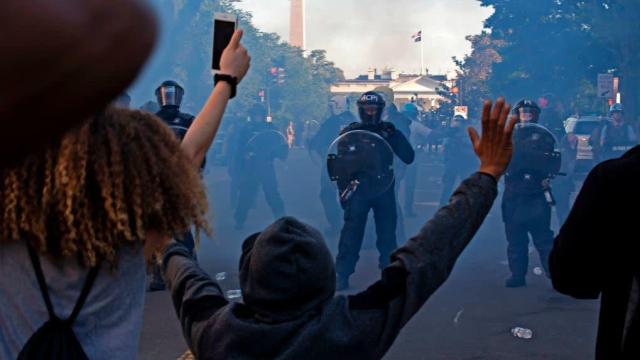Tear gas is a chemical weapon that is banned for use in warfare, yet U.S. police have repeatedly deployed it against people protesting police brutality and anti-black violence this week. Though it’s considered a non-lethal weapon, tear gas is actually far more dangerous than advertised, and is often used without any legal justification.
There are different types of chemicals available as so-called riot-control agents. But the most common ingredient used today in what we call tear gas is 2-chlorobenzylidene malonitrile, or CS. Though also deployed as a spray, the tear gas form of CS is actually a powder that’s aerosolised when the canister or grenade containing it goes off. Like the name implies, the immediate effects of CS exposure include an intense, painful irritation of the eyes that causes crying, spasms, and itching. But the chemical can also affect practically every part of the body that it comes into contact with.
A 2016 scientific review lays out the laundry list of health effects from tear gas. On skin, it can cause redness, itching, rashes, and oozing blisters. When it’s inhaled, the gas causes fits of coughing that can progress to choking and chest tightness. In our eyes, a dose at close range can cause bleeding, tearing of the corneas, and possibly even traumatic nerve damage.
These effects are supposed to be short-lasting and relatively mild, but those assumptions largely come from early animal experiments and small studies involving young, healthy men. As tear gas has become more widely used by police on citizens around the globe over the past few decades, the real-world evidence isn’t so pretty.
For instance, a 2014 study of people living in Turkey — a country with a long history of political instability and protests — found that those who were repeatedly exposed to tear gas were twice as likely to have breathing problems than a control group, and they were also at greater risk of developing chronic bronchitis. (While there’s no research on this yet, it stands to reason that a person injured by tear gas could be more susceptible to covid-19.) Other studies have documented mass chemical burns caused by the explosion of the grenade or a heavy dose, as well as severe eye injuries.
There have also been numerous deaths or severe injuries attributed to the use of tear gas. Sometimes, these deaths are caused by the physical impact of grenades launched at close range, with some weapons capable of hurling them at over 322 km an hour. Other times, as the Centres for Disease Control and Prevention notes, tear gas can cause “immediate death” from severe burns to the throat and lungs.
Pepper spray, the other most common kind of chemical riot-control agent, is also far from harmless. Studies have linked inhaling high doses to “adverse cardiac, respiratory, and neurologic effects, including arrhythmias and sudden death.”
Life-threatening exposures to tear gas and pepper spray are likely most common when they’re used indoors and/or on people with pre-existing respiratory conditions such as asthma. Some police training manuals apparently advise against using tear gas in confined spaces, but a man in Washington D.C. says police shot tear gas into his home on Monday evening, after he invited in protestors who were also being pepper sprayed by police.
Media outlets across the country, as well as numerous social media posts, have documented the indiscriminate use of tear gas and pepper spray by police against peaceful protestors and journalists. In Indiana, for instance, 21-year-old Balin Brake, an editor at a local television station, reportedly lost his left eye after being struck by a tear gas canister during a protest. (Police have denied that the injury was intentional.) Journalists in Minneapolis also reported that police shot at them with tear gas at point-blank range.
According to Dan Kaszeta, a security specialist who has written about the risks of tear gas and other chemical agents in Nature and elsewhere, the unwarranted or unsafe deployment of tear gas by police agencies tends to be the rule, not the exception.
“Tear gas is often used without proper care for consequences of employment. Many of the uses seen in previous days are problematic. Tear gas is originally meant to disperse crowds, but many crowds have legal rights of assembly,” Kaszeta told Gizmodo via email.
Tear gas is famously banned from use in warfare by several international treaties. But government after government has allowed it to be wielded against their own citizens. That this chemical weapon is once again being deployed widely is yet another example of the systemic police brutality that people are protesting in the first place.
Looking for ways to advocate for black lives? Check out this list of resources by our sister site Lifehacker for ways to get involved.
